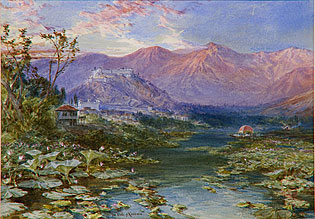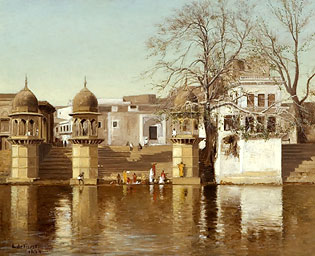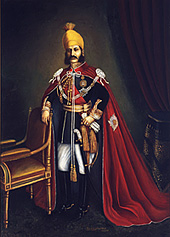
Noted Bay Area collector William K. Ehrenfeld, MD, a pioneering vascular surgeon and professor emeritus of vascular surgery at UCSF, has made an extraordinary gift to the Asian Art Museum of San Francisco.
Ehrenfeld has donated more than 700 paintings, drawings, prints and photographs from South Asia's colonial period (roughly the late eighteenth through the mid-twentieth century). The donation provides a remarkable view of the era, while significantly enhancing the museum's collection of South Asian art, according to Tim Hallman, associate director of marketing & communications at the Asian Art Museum.
Artwork from Ehrenfeld's collection -- formed over 30 years through close attention to the market and keen scholarship and connoisseurship -- will be frequently displayed in the museum's gallery dedicated to South Asian art after 1600.
Ehrenfeld, who reportedly began collecting baseball cards as a young boy, was intrigued with art upon his first visit to a museum at age six. He came to UCSF in 1960 to serve a fellowship and joined the faculty in vascular medicine in 1960.
Ehrenfeld could not be reached for comment for this story. But he was quoted last February in
Asian Art, the newspaper for collectors, dealers, museums and galleries, saying,"People would say my vocation was collecting Indian art and my avocation was vascular surgery. Many are jealous of my retirement since I have done two major exhibitions since retiring in 1992. I had a successful career as an academic vascular surgeon and was former chief of the department, but my true love is Indian art. Although I have never worked as hard as I have at collecting and exhibiting the pieces, I never felt it was work."
|
Ehrenfeld's
generous gift to the museum includes:
•
35
paintings and etchings by perhaps the 20th Century's most renowned Pakistani
painter, Abdur Rahman Chughtai (1897-1975);
•
37 Indian paintings,
including works of the so-called "Company School," works produced by Indian
artists for a largely British and European clientele;
•
more than 100
paintings, drawings and prints by Western artists featuring landscapes,
architectural views, hunting and processional scenes, portraits, studies
of local people and practices, and images documenting historical events;
•
more than 500
19th Century photographs of India, including works documenting local landscapes,
architectural monuments, settings of important historical events; and
•
several art
objects dating from the 18th through 19th centuries including weapons,
central Indian folk bronzes, a lacquered manuscript cover from Tibet,
a South Indian necklace of gold and rudraksha beads, and a silver statue
of a Hindu goddess from South India. |
The museum's research on these and other South Asian artworks will be immeasurably assisted by Ehrenfeld's additional gift of some 885 related books and publications, museum officials say.
"Dr. Ehrenfeld's astute collecting sensibilities aimed at South Asian colonial period art have benefited the museum in an extraordinary way," said Emily Sano, director of the Asian Art Museum. "Dr. Ehrenfeld noticed a gap in our otherwise comprehensive collection of South Asian art, and his gift immediately fills in that space. Moreover, his generosity allows the museum and its visitors an opportunity to study this important period of South Asian art history. We are grateful to Dr. Ehrenfeld for allowing the museum to share this important collection with the entire world."
Colonial Vision of South Asia
The colonial period in South Asia was marked by intense political and cultural changes as local rulers and their kingdoms were absorbed into European commercial and administrative empires. The core of the Ehrenfeld Collection consists of paintings, prints, drawings and photographs by British and European artists that serve as important testaments to this historical meeting of cultures. Apart from illustrating the colonial vision of South Asia, many of the artworks provide remarkable insights into the self-image and character of imperial power.
European paintings, prints, and photographs from this period indicate the multiple ways in which knowledge of South Asia was gathered and spread by visual means. As Great Britain was the dominant colonial power in the region until 1947, the works of British artists are especially revealing. Their depictions of "exotic" landscapes, peoples, and practices--not to mention battles, rebellions, and their staging grounds--provide visual documentation of Britain's domination of its colonial territories.
 |
| The Lake of Kashmir, 1893, by William Simpson. (See larger) |
Among the highlights of Ehrenfeld's gift, and one that illustrates this particular type of visual documentation, is a water color by English artist William Simpson (1823-99) titled "The Lake of Kashmir," dated 1893. In this impressionistically rendered painting, Simpson captures the famous Dal Lake, claimed by many of his contemporaries as one of the most beautiful spots in the world. The establishment of British authority in India paved the way for many British artists, like Simpson, to seek their fortunes on the subcontinent. These artists made extensive tours throughout India, sketching various scenes and sites which were then worked up to be issued as prints back home in England.
British public interest in India was especially strong after the 1857 Mutiny, when native Indian military forces rebelled against their British superiors. The British eventually crushed the rebellion but the Mutiny led to Queen Victoria's official proclamation of India--which had formerly been overseen by the East India Company--as a possession of the British Crown. The works of various artists who surveyed India in the Mutiny's aftermath can be viewed, in many ways, as visual records of England's latest, and most valuable, conquest. Simpson first visited India in 1859 in order to gather together sketches for an illustrated book on India to be published by the London company of Day and Sons. Several additional original watercolors by Simpson are included in the Ehrenfeld gift as well as published lithographs.
 |
| One of the Twenty-four Bathing Ghats at Mathura, 1894, by Lockwood de Forest (1850-1932). (See larger) |
An especially important painting in the Ehrenfeld gift is "One of the Twenty-four Bathing Ghats at Mathura," an 1894 oil on canvas painting by American artist Lockwood de Forest (1850-1932). This expertly rendered landscape features buildings, kiosks, and steep stairs that line the banks of the Jumna River in the city of Mathura. The work is a particularly strong example of the fashionable preoccupation among many Western artists of the nineteenth century with Indian architecture and "Orientalist" décor.
Lockwood de Forest, who is perhaps best known for his partnership with Louis Comfort Tiffany in the interior design firm of Associated Artists, trained as a landscape painter with the famous Hudson River artist Frederic Church. He visited India in 1879 while on his honeymoon and encountered there various "Oriental" objects with which to supply his decorating firm. As the taste for such exotic furnishings had subsided by the end of the nineteenth century, de Forest eventually sold the remainder of his extensive stock to Tiffany and moved to Santa Barbara, CA, where he resumed his early interest in landscape painting. This work is one of his few known Indian paintings.
 |
| Nawab Mir Mahbub Ali Khan Bahadur, Asaf Jah VI, the Nizam (ruler) of Hyderabad (reigned 1884-1911), 1906, by Moujdar Khan. (See larger) |
Apart from works by Western artists, the Ehrenfeld Collection also includes a considerable number of paintings and photographs by South Asian artists. These serve to highlight traditional artists' practices, the responses of those artists to shifting political circumstances, and their adaptation of European artistic forms and techniques. Avibrant oil on canvas portrait of Mir Mahbub Ali Khan (1866-1911), the sixth Nizam of Hyderabad, is a striking example of the Indian artist's ability to adapt European painting and stylistic conventions. In the history of Indian painting, artists have, for the most part, remained anonymous. In this instance, the artist has signed his work, but nothing else is known of him. The portrait is based on a photograph by the Nizam's court photographer Lala Deen Dayal (1884-1910), one of the earliest and best-known Indian photographers of the late-nineteenth to early twentieth century. A number of Lala Deen Dayal's photographs are part of the Ehrenfeld gift.
The Indian artist's exposure to European artistic styles began much earlier than the colonial period, as another work in the Ehrenfeld Collection illustrates. The artist of a seventeenth-century Mughal drawing, inspired in part by Raphael's cartoon for a tapestry depicting the Death of Ananais, adopts several European conventions while inserting decidedly Indian elements as well. Several figures have been derived from Raphael's cartoon but they are set in an Indian landscape which is studded with shrines and temples. This work, in addition to many others in the Ehrenfeld Collection, provides the opportunity to present to the museum's public the different facets of a long-standing interaction between India and the European world.
All of the above-mentioned works, in addition to 42 others in the Ehrenfeld gift, were shown in the 1998 traveling exhibition Interaction of Cultures: Indian and Western Painting 1780-1910. Ehrenfeld's considerable and varied collection of South Asian art has been the focus of two additional scholarly exhibitions: Indian Miniatures: The Ehrenfeld Collection (1985) and Reverie and Reality: Photographs of India from the Ehrenfeld Collection (2003).
Photographs by Kaz Tsuruta
Source: Asian Art Museum
Related Links
Asian Art Museum



